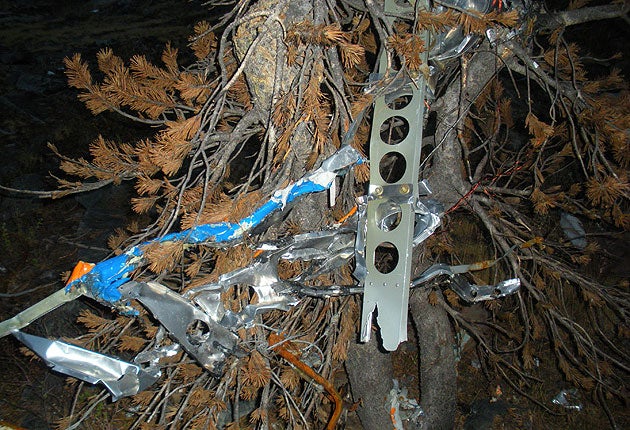In a remote mountain region of eastern California, rescue workers yesterday discovered body parts inside the wreckage of a light aircraft belonging to Steve Fossett, the record-breaking aviator who vanished just over a year ago.
The remains of Fossett's single-engined Bellanca aeroplane were found near the summit of a ridge 10,000 feet above sea level in the Ansel Adams Wilderness section of the two-million acre Inyo National Forest.
Last night, Mark Rosenker, the acting chairman of the National Transportation Safety Board, said that his searchers had discovered enough human remains to provide coroners with a DNA sample, but did not elaborate on what exactly they had found.
Local Sheriff John Anderson said that most of the aircraft's fuselage, which was made from wood and fabric, disintegrated on impact with the thickly-forested hillside, but its engine was found several hundred feet away from the initial impact site.
The exact location was being kept under wraps yesterday. However, it is reported to be roughly a hundred miles due south of the Nevada desert airfield from which Fossett set off on the morning of 3 September 2007.
Searchers began combing the area after a local ski-shop owner, Preston Morrow, stumbled upon several items of the 62-year-old adventurer's personal belongings in a patch of thick undergrowth while walking his dog. They included two ID cards, a black sweatshirt and $1,000 (£570) in cash.
"I came across the ID card, another card and the 100-dollar bills in the dirt and the pine needles and stuff and I went, 'wow'," Mr Morrow told reporters. "There wasn't a picture of Fossett, but there was a name and ID and stuff ... It didn't pop in my head right at that time who that was."
The discovery of the remains may finally reveal the fate of Fossett, who had set more than 100 world records before he failed to return to the Flying M Ranch, a remote private airfield owned by the hotel magnate Barron Hilton, after what was described as a routine pleasure flight.
His disappearance sparked one of the biggest peacetime search-and-rescue operations in American history, covering 20,000 square miles and centring on a wide area of desert he was thought to have been scouting for a new land-speed record attempt.
Despite the massive operation, which lasted for over a month, no trace of the aviator was found. In February, a court in Chicago – where he made his fortune – pronounced him legally dead.
Soon afterwards, conspiracy theories began circulating that Fossett might have faked his own death in order to escape personal or financial problems, or to secure an insurance payout for his wife of 39 years, Peggy.
They wondered how such an experienced pilot could have got into difficulty in a simple and reliable aircraft on a clear day in almost perfect flying conditions. They also found it difficult to believe that experienced investigators with state-of-the-art equipment could have failed to find a crashed aircraft.
Although the conspiracy theorists are unlikely to be totally silenced until the DNA samples are confirmed as belonging to Fossett, his friends said yesterday they hoped the discovery of his aircraft might dampen the speculation about his disappearance. In an interview with Sky News, Sir Richard Branson, who had collaborated with Fossett on several of his famous world record attempts, said he believed the find was genuine.
"The positive thing is that today a couple of stories that have appeared in the press will be put to rest once and for all, and everybody who was close to Steve will have the chance now to pay the right tribute to what was a truly great and extraordinary person," Sir Richard said
"They're definitely authentic belongings, it was his pilot licence, his driver's license, it was also a membership card to the National Aeronautic Association, which gave Stephen an award a couple of years ago. He also often carried 100-dollar bills with him, so we are certain that these are genuine findings."
Yesterday, accident investigators were busy working out how Fossett's aircraft came to grief. Experts said the topography of the area could have contributed to an accident, if a pilot flew into one of the mountain gullies which suddenly narrowed before he had time to manoeuvre himself out of it.
The authorities were also trying to establish how the wreckage was initially missed by search and rescue teams. The Nevada Civil Air Patrol, which co-ordinated the operation, said teams had flown over the Mammoth area, but admitted it was away from their main area focus.
Locating wreckage in the eastern area of the Sierra Nevada can be especially difficult because of the dense woodland which covers much of the ground, and the fact that almost every hillside has hundreds of gullies, which need to be searched individually.
Earlier in the day, Mr Fossett's wife, Peggy, issued a statement saying that she was monitoring the situation closely and hoped the search would find her husband's remains.

Join our commenting forum
Join thought-provoking conversations, follow other Independent readers and see their replies
Comments